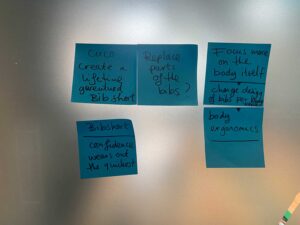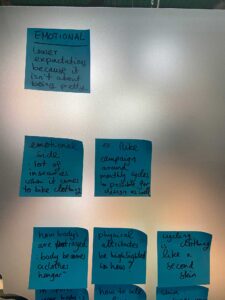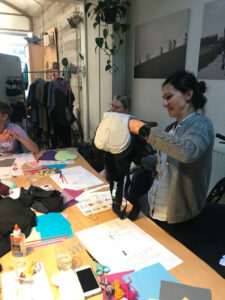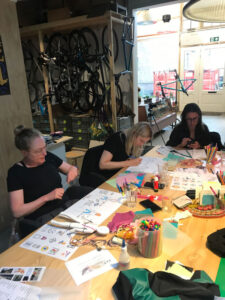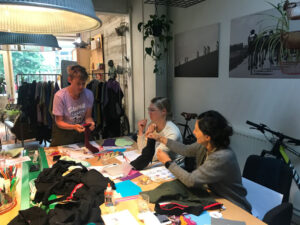Research questions
Body and fashion: How can my body influence the manufacturing process in fashion?
Themes
Exhaustion, Movement, Somatic, Nature, Outdoors, Sport, Ephemeral, Transience, New-Materialism, Performance, Corporeal, Artistic Translation.
Intro

During my RiP I was keen on capturing my love for the outdoors and movement within the context of fashion. My goal was to investigate ways to normalize ordinary bodies as competitive adversaries in cycling and elevate cycle wear to the status of couture.
From 11 May to 11 July, I applied to intern at I R I S – I Ride In Style cycling apparel for women in Rotterdam where I had the opportunity to develop a better understanding of the literal and metaphorical role the body, senses and identity play in the production of garments – and how we can create a more emotional and affective relationship between the matter that we wear and our bodily functions especially within the realm of activewear.
My research as well as the goal of I R I S is rooted in the search for solutions to dimmish the impact fashion has on the world.
Activities
Brainstorming
Themes we discussed
Emotional Side
- A lot of insecurities when it comes to bike clothing. It is soo damn tight and shows all my flaws.
- Ex Nike campaign around monthly cycles (women menstrual cycles)-> possible for design as well.
- Lower expectations when cycling, because it isn’t about looking pretty.
- How bodies are portrayed in fashion magazines: body becomes a clothes hanger.
- Physical attributes should be highlighted -> HOW?
- Cycling clothing/clothing is like a second skin.
- In sports, your body is the most important thing you have. Why then do we underestimate it?
- How to sell cycling clothes in a different way. It’s not necessarily about being fast and in shape. It is about having fun right?
- Skin captures your sweat, blood etc. So does lycra.
- Champion the sweat, be proud of it.
- I R I S.cc, shows more fun and social pictures. Yay!
- Judging yourself, people gazing -> takes the fun out of exercising.
- Bodies are meant to move no matter what size you are.
- Why all this negativity around (fat)bigger bikers?
- Find the fun in exercising. Don’t do it as a punishment or to become skinny.
- “If I’m not the fastest biker, I can be the one who bikes the longest”. Or the one who just loves to ride?
- Culture difference: Size inclusion. ‘There is no 1-way’
- Approach it differently: How do we talk about/address it (body’s) and not talk about/address it.
Communication / Marketing
- How we see our body and communicate it.
- Road bikers, like brand new and clean while MTB wear it as a badge of honour (scars, holes in clothing etc).
- Maybe it is more about educating people rather than changing the design.
- When the product looks better on a model it sells better.
- Why such a difference between MTB and road bike clothing.
Design
- Circo (circular economy) – create a lifetime guaranteed Bib short.
- Replace parts of the bibs.
- Focus more on the body itself – change the design of bibs per body type.
- Bibshort: People should have confidence when wearing them. It is also the garment that wears out the quickest.
- Body ergonomics.
- See every different body shape as a different canvas.
- What are different bodies in need of? How to accommodate this?
Idea
Iris S, Iris J and myself all have different body types and different backgrounds as cyclist and we felt that we could augment our brainstorm session by collecting even more data and feedback from the cycling community. The meeting concluded with an idea for a workshop where we would invite the end-user to the I R I S offices to dive deeper into their needs from cycling apparel as well as get feedback about their emotional and psychological experiences as cyclist.
We had some assumptions about what the outcomes would be, based on our own personalities and experience as cyclists. Under the tutelage and guidance of Iris Jönsthövel, we created a context mapping workshop to improve the I R I S product line. I was responsible for most of the writing, content and structural design of the workshop but also helped with the layout and facilitating the workshop, titled Bibs for all Booties, held on June 25th, 2021.
The project consisted of three phases. On-boarding (via an email and SM campaign), sensitizing (via a 5-day workbook) and the eventual workshop. We went through various iterations of the content, with the sensitizing workbook proving the most difficult to perfect. Iris J, has led many workshops and shared interesting insights on participant psychology. She had useful feedback on logical/structural layout and how to prevent your own biases from affecting the design. She also cautioned against making the workbooks look too nice, as people won’t want to write in them and ruin the aesthetics (so weird!).
Sentizing Workbook (It's really cool, check it out)
Research notes for the workshop
Ideas and quotes were collected from various sources but a lot was taken from the Shimano ‘All bodies on Bikes’ campaign.
- There is a void in cycle community. Let’s cater more to women!
- More size inclusion to make cycling accessible to everyone and all levels of fitness.
- There is no one right way to ride a bike. Find adventure in your own backyard.
- To be a cyclist you just have to be a person riding a bike.
- Being fast is not what makes you an experienced rider.
- Negative associations with the word fat = lazy, unhealthy, ugly, undesirable
- Fat is just a descriptor of a type of body. Why this negative association to certain words?
- We all have self-doubt. When society tells you you are ugly it’s hard to even start.
- Do you feel bad when you are at the back? Do you feel left behind? Do you prefer riding with people with the same fitness level as you? Do you want to ride with faster people to improve? Do you want to ride slower to heal from pain?
- I felt stronger than I thought I was.
- People get emotional and personal no matter what size body they have. It’s been a negative relationship until recently. It felt that my body was holding me back, if only I was in a smaller/bigger body. I would be treated differently/liked/taken
- What is my body going to do today? I didn’t sleep. I’m on my period, I’m stressed, and I have aches.
- Tension between accepting my body for what it is and accepting the journey my body wants to take me on and wanting to push my body further. I struggled to find where I stand in this tension for me the motivation to cycle to lose weight was not a healthy way for me to approach cycling.
- I used cycling as a form of punishment because I thought it was gonna make my body smaller. I started to restrict what I was eating. I was soo hyper focussed on losing weight. I ate so little, I was lightheaded.
- You have to punish yourself like this so you have the body you are supposed to have.
- Why do you think your body needs to be smaller?
- Think critically about how I was treating myself and thinking about myself. You start to question, why do we start thinking its better to be thin than fat? Why do we associate all these negative things with fatness? It’s hard trying to push back against that? I’m not going to accept what everyone else tells me is the ideal in myself or in other people. To accept yourself is by telling yourself a totally different narrative than what the world is telling you. It’s a constant battle. There is so much more to a person than their weight. My body size doesn’t make me who I am as a person.
- The primary reason we cycle is to have fun.
Workshop
Our aim was to invite 5 people to participate, and our demographic was anyone who had an interest in refining female-specific bib shorts (read anyone with a butt and boobies). Contrary to our expectations, we got an overwhelming response. There was a lot of enthusiasm from the I R I S community to join and share their experience and advice on female-specific bike clothing. This obviously indicates a lack of awareness, voices, and options within the realm of cycling apparel, opening up a lot of scope for brands to improve what they offer to women (read anyone with a butt and boobies).
If design is defined as an inquiry into the future situation of use. Then co-design is the collaborative exploration of future situations of use - Liz Sanders.

Workshop findings
The 3-hour workshop became a 5-hour soiree where 5 + 3 ladies gossiped, joked and lamented the woes of balancing fitness with femineity (or not, ladies choice).
The value extrapolated from this workshop is worth its weight in gold and affirms the ethos of MFS that collaboration yields more fruitful insights than working alone.
The data from this workshop are tabulated below and will be applied to tailoring future strategies for the I R I S brand.
 Instagram
Instagram
Iris J created a beautiful graphic summary of the content for Instagram! Click the pic below to check it out.
Methodologies
The Context mapping methodology was developed at ID-StudioLab, Delft University of Technology, The Netherlands by Froukje Sleeswijk Visser and Pieter Jan Stappers. It is a methodology that product designers use to illicit latent knowledge from end-user to eliminate speculation as to the context in which products/services are used. Context mapping is almost always conducted within a facilitated workshop. The methodology avoids leading questions and priming tactics that could cloud the data but rather focuses on exposing tacit knowledge in a natural and authentic way. Like art education, it relies a lot on ‘play’, scrapbooking and being creative to generate data. Collective creativity is better than individual creativity, right? Facilitators record the sessions and interpret the user-generated content. The insights are used for inspiration and ideation to improve future products and services.




